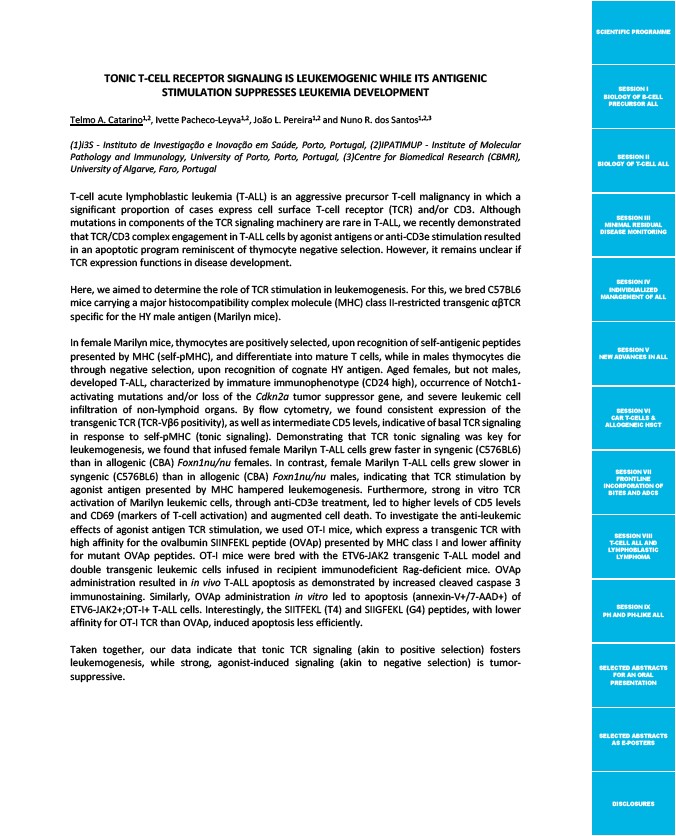
SCIENTIFIC PROGRAMME
SESSION I
BIOLOGY OF B-CELL
PRECURSOR ALL
SESSION II
BIOLOGY OF T-CELL ALL
SESSION III
MINIMAL RESIDUAL
DISEASE MONITORING
SESSION IV
INDIVIDUALIZED
MANAGEMENT OF ALL
SESSION V
NEW ADVANCES IN ALL
SESSION VI
CAR T-CELLS &
ALLOGENEIC HSCT
SESSION VII
FRONTLINE
INCORPORATION OF
BITES AND ADCS
SESSION VIII
T-CELL ALL AND
LYMPHOBLASTIC
LYMPHOMA
SESSION IX
PH AND PH-LIKE ALL
SELECTED ABSTRACTS
FOR AN ORAL
PRESENTATION
SELECTED ABSTRACTS
AS E-POSTERS
DISCLOSURES
TONIC T-CELL RECEPTOR SIGNALING IS LEUKEMOGENIC WHILE ITS ANTIGENIC
STIMULATION SUPPRESSES LEUKEMIA DEVELOPMENT
Telmo A. Catarino1,2, Ivette Pacheco-Leyva1,2, João L. Pereira1,2 and Nuno R. dos Santos1,2,3
(1)i3S - Instituto de Investigação e Inovação em Saúde, Porto, Portugal, (2)IPATIMUP - Institute of Molecular
Pathology and Immunology, University of Porto, Porto, Portugal, (3)Centre for Biomedical Research (CBMR),
University of Algarve, Faro, Portugal
T-cell acute lymphoblastic leukemia (T-ALL) is an aggressive precursor T-cell malignancy in which a
significant proportion of cases express cell surface T-cell receptor (TCR) and/or CD3. Although
mutations in components of the TCR signaling machinery are rare in T-ALL, we recently demonstrated
that TCR/CD3 complex engagement in T-ALL cells by agonist antigens or anti-CD3e stimulation resulted
in an apoptotic program reminiscent of thymocyte negative selection. However, it remains unclear if
TCR expression functions in disease development.
Here, we aimed to determine the role of TCR stimulation in leukemogenesis. For this, we bred C57BL6
mice carrying a major histocompatibility complex molecule (MHC) class II-restricted transgenic αβTCR
specific for the HY male antigen (Marilyn mice).
In female Marilyn mice, thymocytes are positively selected, upon recognition of self-antigenic peptides
presented by MHC (self-pMHC), and differentiate into mature T cells, while in males thymocytes die
through negative selection, upon recognition of cognate HY antigen. Aged females, but not males,
developed T-ALL, characterized by immature immunophenotype (CD24 high), occurrence of Notch1-
activating mutations and/or loss of the Cdkn2a tumor suppressor gene, and severe leukemic cell
infiltration of non-lymphoid organs. By flow cytometry, we found consistent expression of the
transgenic TCR (TCR-Vβ6 positivity), as well as intermediate CD5 levels, indicative of basal TCR signaling
in response to self-pMHC (tonic signaling). Demonstrating that TCR tonic signaling was key for
leukemogenesis, we found that infused female Marilyn T-ALL cells grew faster in syngenic (C576BL6)
than in allogenic (CBA) Foxn1nu/nu females. In contrast, female Marilyn T-ALL cells grew slower in
syngenic (C576BL6) than in allogenic (CBA) Foxn1nu/nu males, indicating that TCR stimulation by
agonist antigen presented by MHC hampered leukemogenesis. Furthermore, strong in vitro TCR
activation of Marilyn leukemic cells, through anti-CD3e treatment, led to higher levels of CD5 levels
and CD69 (markers of T-cell activation) and augmented cell death. To investigate the anti-leukemic
effects of agonist antigen TCR stimulation, we used OT-I mice, which express a transgenic TCR with
high affinity for the ovalbumin SIINFEKL peptide (OVAp) presented by MHC class I and lower affinity
for mutant OVAp peptides. OT-I mice were bred with the ETV6-JAK2 transgenic T-ALL model and
double transgenic leukemic cells infused in recipient immunodeficient Rag-deficient mice. OVAp
administration resulted in in vivo T-ALL apoptosis as demonstrated by increased cleaved caspase 3
immunostaining. Similarly, OVAp administration in vitro led to apoptosis (annexin-V+/7-AAD+) of
ETV6-JAK2+;OT-I+ T-ALL cells. Interestingly, the SIITFEKL (T4) and SIIGFEKL (G4) peptides, with lower
affinity for OT-I TCR than OVAp, induced apoptosis less efficiently.
Taken together, our data indicate that tonic TCR signaling (akin to positive selection) fosters
leukemogenesis, while strong, agonist-induced signaling (akin to negative selection) is tumor-suppressive.